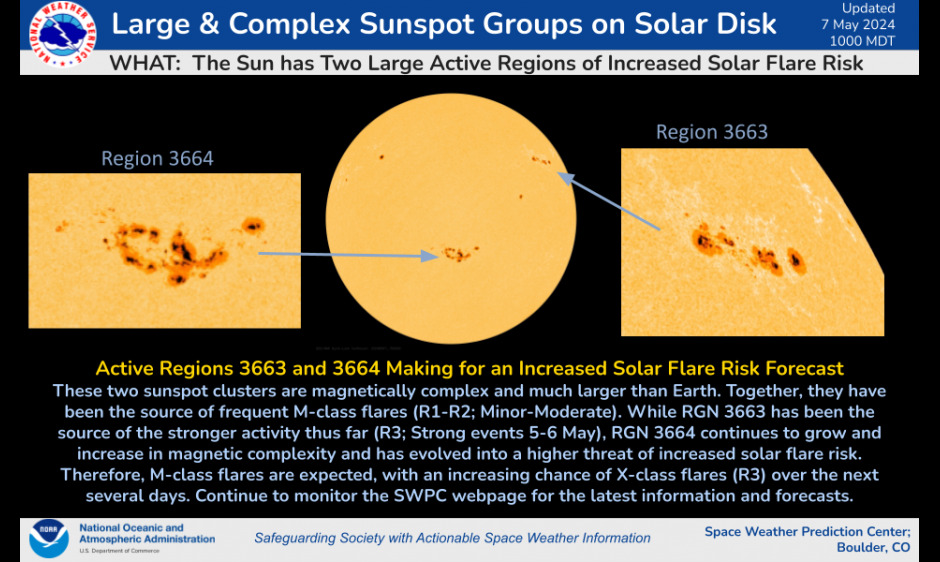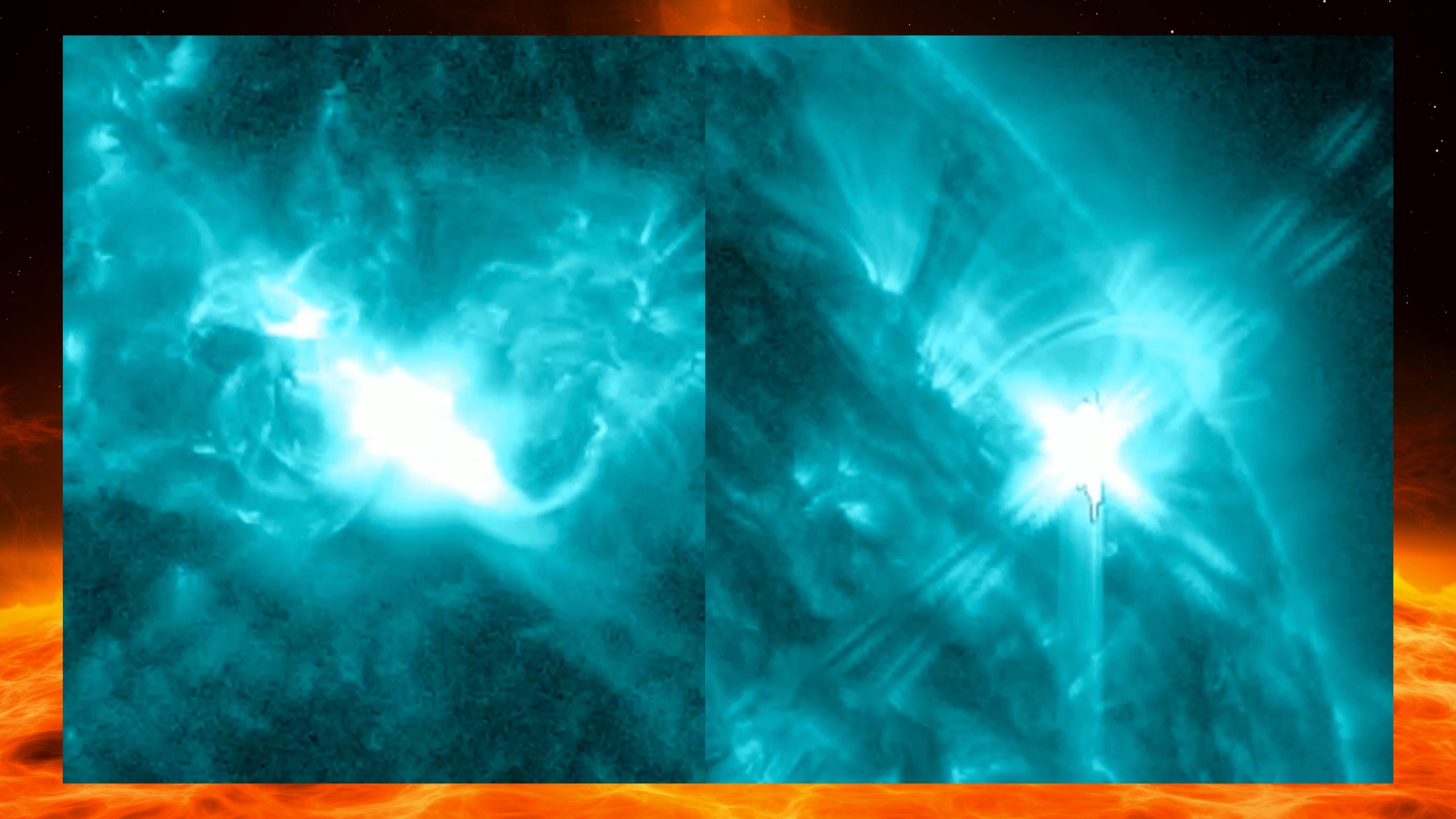Sun explodes in a flurry of powerful solar flares from hyperactive sunspots (video)
Explosive sunspot AR3663 and its bigger cousin AR3664 are the current main solar flare players, unleashing flare after flare. We're struggling to keep up!
The most active sunspot of Solar Cycle 25, AR3663, has done it again! Launching yet another X-class solar flare as it approaches the sun's western limb. And it's not alone; its sunspot 'cousin' AR3664 also unleashed an X-flare and several M-class solar flares. The pair of sunspots don't look like stopping anytime soon.
The two most recent solar flares erupted from AR3663 and AR3664, respectively. The first occurred at 9:42 p.m. EDT on May 7 (0142 GMT on May 8) and the second just a few hours later at 1:08 a.m. EDT (0508 GMT) this morning (May 8) according to spaceweatherlive.com.
It's hard to keep up with these hyperactive sunspots. Since May 3, AR3663 has spawned five X-class solar flares and over 20 M-flares, far more than any other sunspot in the past seven years according to spaceweather.com.
Related: 2 colossal solar flares explode from the sun and Earth is in the firing line (video)
Meanwhile, AR3664 has more than doubled in size in just 48 hours, becoming one of the largest sunspots seen this solar cycle.
Massive sunspot region 3664 grows and becomes more complex over past two days in this footage courtesy of https://t.co/LZr8ncHIgv See our follow-up post about what this means for solar flare probabilities over the next few days and visit https://t.co/9n7phHb5ok for the latest! pic.twitter.com/lcW621YqX1May 7, 2024
The National Oceanic and Atmospheric Administration (NOAA) Space Weather Prediction Center (SWPC) has issued an increased solar flare risk warning due to the continued growth of sunspot AR6634, which has advanced in both size and complexity.
"Region 3664 has grown considerably and has become much more magnetically complex," NOAA's SWPC reports. "This has led to increased solar flare probabilities over the next several days."
Get the Space.com Newsletter
Breaking space news, the latest updates on rocket launches, skywatching events and more!

Solar flares are eruptions from the sun's surface that emit intense bursts of electromagnetic radiation. They occur when magnetic energy accumulating in the solar atmosphere is subsequently released. Solar flares are categorized by size into lettered groups, with X-class being the most powerful. Then there are M-class flares that are 10 times less powerful than X-class flares, followed by C-class flares which are 10 times weaker than M-class flares, B-class are 10 times weaker than C-class flares and finally, A-class flares which are 10 times weaker than B-class flares and have no noticeable consequences on Earth. Within each class, numbers from 1-10 (and beyond for X-class flares) describe a flare's relative strength.

While AR3663 will be disappearing behind the sun's western limb by the end of the week, developing behemoth sunspot AR3664 poses a greater threat for X-flares as it becomes more magnetically complex, according to Spaceweather.com.
"Among the sunspot's dark cores, magnetic poles of opposite polarity are bumping together in explosive proximity," Spaceweather.com reports.
And it looks like it's living up to its reputation as an emerging X-flare player, with the recent X-flare eruption this morning.
"Sunspot region AR3664 has been strangely silent from a flare point of view although it is an angry looking region." Solar Physicist Keith Strong posted on X. "Just a couple of hours ago it awoke, producing an X1 flare, the second of the day. It is a sprawling sunspot group in the SW".
TWO REGIONS PRODUCING X FLARES - PART 2: Sunspot region AR3664 has been strangely silent from a flare point of view although it is an angry looking region. Just a couple of hours ago it awoke, producing an X1 flare, the second of the day. It is a sprawling sunspot group in the SW pic.twitter.com/AQ7beSLCGRMay 8, 2024
According to space weather and aurora website SolarHam's post on X. The recent X-flare from AR3664 was accompanied by a coronal mass ejection (CME), a large expulsion of plasma and magnetic field from the sun, which is predicted to pass Earth within the next 48 to 72 hours. Even a glancing blow from this CME could trigger a geomagnetic storm so aurora watchers be on the lookout!
Geomagnetic storms, also known as solar storms, are disturbances to Earth's magnetic field caused by CMEs. When energized particles from the sun slam into Earth's atmosphere, our planet's magnetic field funnels them toward the poles. The supercharging of molecules in Earth's atmosphere triggers the colorful spectacles, which usually remain limited to areas at high latitudes for the aurora borealis (northern lights) and low latitudes for the aurora australis (southern lights).
Scientists are keeping a watchful eye on both of these hyperactive sunspots as their flaring activity doesn't look like slowing down anytime soon. At the time of writing, AR3664 released another powerful M-class solar flare measuring M.69 during the peak at 08:04 a.m. EDT (1204 GMT). It's a hard job keeping track of all these powerful solar flares! The sun has definitely woken up as we approach solar maximum, the most active period during the sun's approximately 11-year solar cycle.
Join our Space Forums to keep talking space on the latest missions, night sky and more! And if you have a news tip, correction or comment, let us know at: community@space.com.

Daisy Dobrijevic joined Space.com in February 2022 having previously worked for our sister publication All About Space magazine as a staff writer. Before joining us, Daisy completed an editorial internship with the BBC Sky at Night Magazine and worked at the National Space Centre in Leicester, U.K., where she enjoyed communicating space science to the public. In 2021, Daisy completed a PhD in plant physiology and also holds a Master's in Environmental Science, she is currently based in Nottingham, U.K. Daisy is passionate about all things space, with a penchant for solar activity and space weather. She has a strong interest in astrotourism and loves nothing more than a good northern lights chase!









